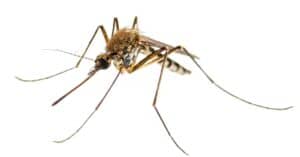Mosquitoes are a worldwide concern because they spread diseases like malaria, creating painful, itching bites. The death toll from malaria in the 20th century ranged from 150 to 200 million, which accounted for 2-5% of overall human deaths. Mosquito species live on every continent except Antarctica, and in North America, there are numerous species on the Atlantic coast. Let’s discover eight types of mosquitoes set to invade Georgia this year and how you can avoid them.
Mosquito Types in Georgia
There are more than 200 mosquito species in the U.S., and 12 of them carry diseases or pathogens. Georgia is home to 63 species. In fact, according to Orkin’s 2021 mosquito cities list, Atlanta, Georgia, takes second place for the worst mosquito-infested city.
The top three worst mosquito species in Georgia are Culex, Anopheles, and Aedes, and they all have many subspecies. Female mosquitoes bite mammals, birds, reptiles, and amphibians. They need blood to create viable eggs.
Mozzies breed at a tremendous rate, utilizing water sources during humid, wet weather to lay eggs that develop into larvae and eventually fly, biting mosquitoes we all love to hate.
Here are eight types of mosquitoes set to invade Georgia this year.
1. Asian Tiger Mosquito (Aedes albopictus)
Tiger mosquitos aren’t native to the U.S. They arrived in the 1980s on car tires imported from Hong Kong and soon made their way into the environment. Georgia’s warm, humid weather suited them perfectly.
These mozzies are floodwater mosquitoes. They emerge when temperatures reach 50 degrees from eggs laid in damp soil or rainwater collection points such as plant pot saucers, water butts, birdbaths, and even mud. Asian tiger mosquitoes need very little moisture to breed prolifically.
They are easily recognizable with dark brown abdomens and white scales that create tiger-like stripes. Tiger mosquitoes inflict painful bites during the day and night and transmit diseases like Zika virus, West Nile virus, chikungunya, dengue fever, and eastern equine encephalitis.
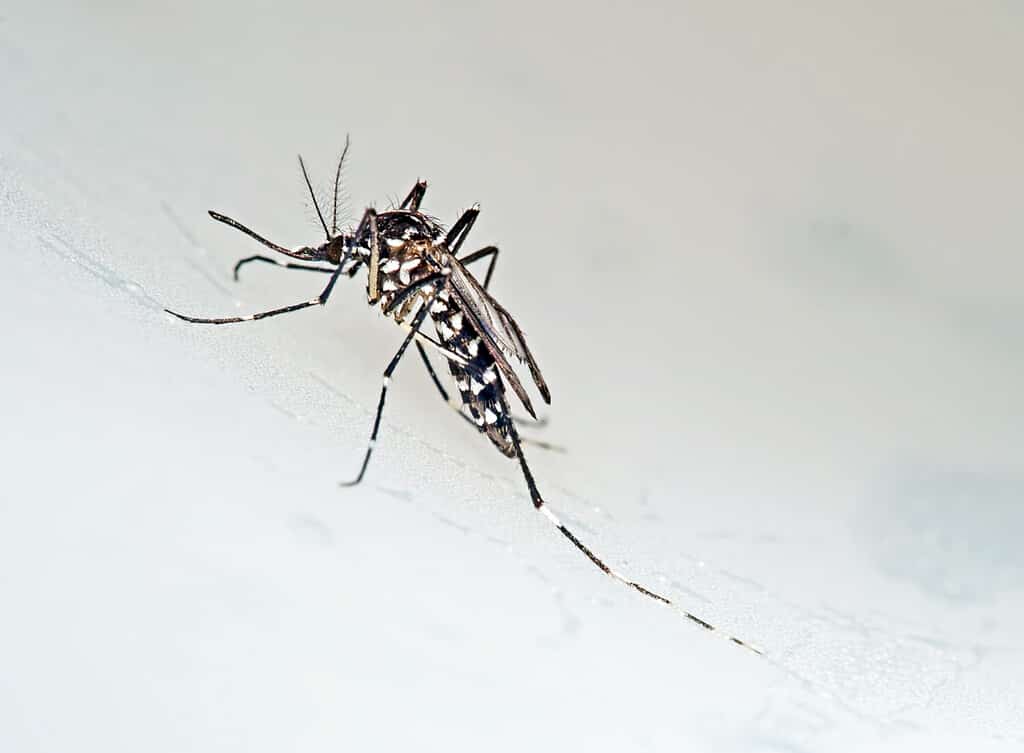
They are easily recognizable with dark brown abdomens and white scales that create tiger-like stripes.
©Sarah2/Shutterstock.com
2. Southern House Mosquito (Culex quinquefasciatus)
The southern house mosquito is Georgia’s primary West Nile virus vector but also spreads avian malaria, Zika, and St. Louis filariasis.
It’s a medium-sized brown mosquito with golden scales and white stripes. Its proboscis, wings, and thorax are darker. The common name “southern house mosquito” refers to its preference for indoor spaces. It can become a real nuisance in homes without shutters or air conditioning, especially at dusk and through the night when females prefer to feed.

This is Georgia’s primary West Nile virus vector but also spreads avian malaria, Zika, and St Louis filariasis.
©iStock.com/Arnav Ray
3. Florida SLE Mosquito (Culex nigripalpus)
Florida is in its name, but this painful biting mosquito does not respect state lines. It’s common in warm, humid coastal habitats like Georgia and is one of the worst mosquitos for disease vectors. During summer months, Florida SLE mosquitoes venture north, but larvae and eggs are killed when temperatures freeze.
It’s a medium-sized brown mosquito with a darker proboscis and a bronze sheen with white narrow dorsal bands. It searches out blood meals from humans, mammals, birds, and reptiles and prefers to lay eggs in newly flooded ditches.
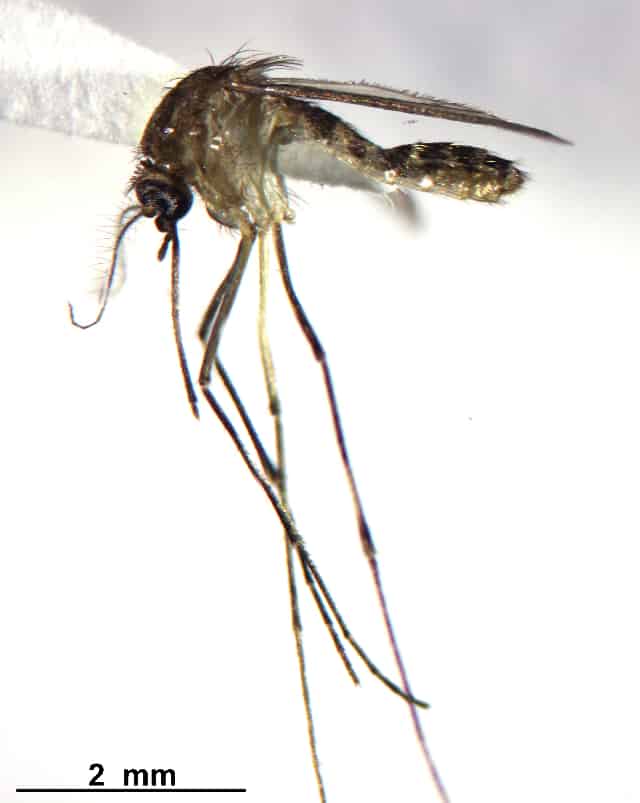
It’s a medium-sized brown mosquito with a darker proboscis and a bronze sheen with white narrow dorsal bands.
©BOLD Systems, Rahuel Chan/CC BY 3.0 – License
4. Common Malaria Mosquito (Anopheles quadrimaculatus)
Common malaria mosquitoes were the main vector for U.S. malaria outbreaks in the past, hence the common name. These biters prefer to feed on large mammals and lay their eggs on clean water surfaces such as slow-moving rivers and marshes or pump-filtered ponds.
They appear dark brown or black with a round dorsal shield and scaly black and white wings. Common malaria mosquitos in Georgia are crepuscular, so they prefer to take blood in the hours of dawn and dusk. This very common mosquito is set to invade Georgia every year.
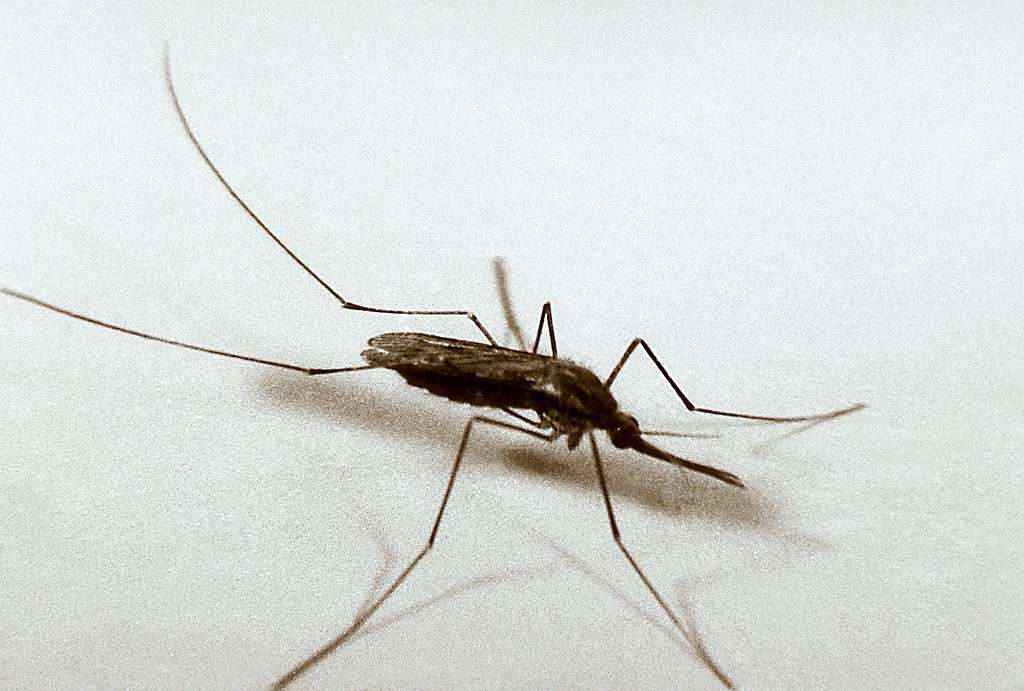
These biters prefer to feed on large mammals and lay their eggs on clean water surfaces such as slow-moving rivers and marshes or pump-filtered ponds.
©https://pixnio.com/fauna-animals/insects-and-bugs/mosquito/close-up-photograph-of-an-anopheles-quadrimaculatus-mosquito-on-white-background# – License
5. Winter Marsh Mosquito (Culiseta inornate)
One of the few cold-weather mosquitos found in Georgia is the winter marsh mosquito. It’s much larger than other species, measuring up to an inch in length, and has no banding or speckles. It’s a real problem in forests with standing water throughout the year. They feed from humans, horses, and ruminants, biting them fiercely at night all year round.
This mosquito carries disease and breeds prolifically in wet winters because it takes advantage of the standing water.
6. Yellow Fever Mosquito (Aedes aegypti)
The yellow fever mosquito is native to Africa and was transported to North America through the slave trade. It’s only invaded a few areas of Georgia, but it’s a concern because it’s a vector for dangerous yellow fever.
This mosquito lays eggs in containers of water such as plant pots, bird baths, swimming pools, and drainage ditches. Interestingly, since the introduction of Asian tiger mosquitoes, yellow fever mosquito numbers have fallen. Experts think it might be because tiger mosquitoes outcompete them or even interbreed and produce sterile offspring.
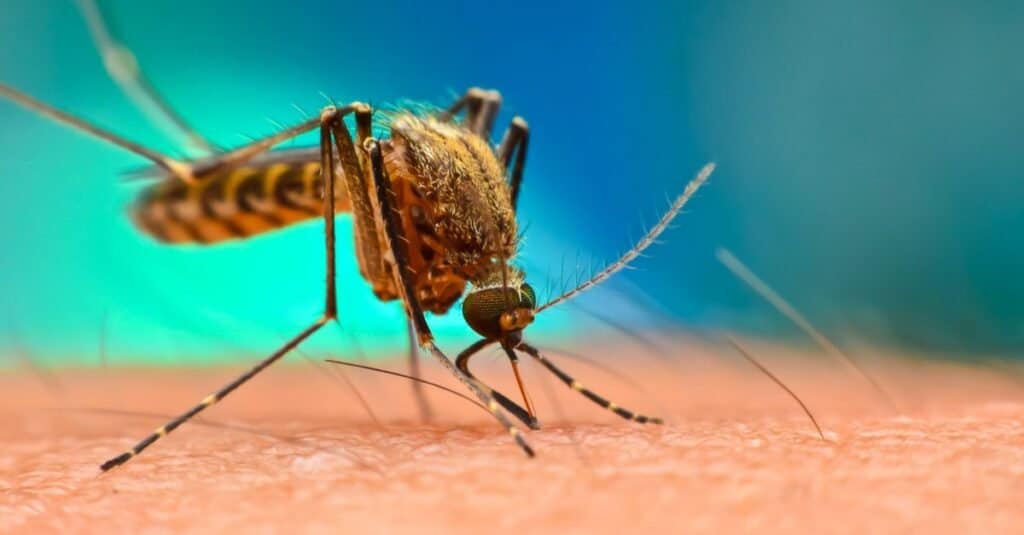
This mosquito lays eggs in containers of water such as plant pots, bird baths, swimming pools, and drainage ditches.
©Digital Images Studio/Shutterstock.com
7. Upland Floodwater Mosquito (Aedes vexans)
Upland floodwater mosquitoes breed in freshwater pools, and adults tend to stay nearby. They have a distinctive B shape on their abdomens and bite chiefly at dawn and dusk when it’s cooler, but they are known to bite in the mid-day shade, too. Large mammals like horses, cows, and humans are their preferred targets.
This mosquito carries vectors such as the rare Bunyaviridae virus, also called Crimean-Congo hemorrhagic fever. It’s one of the mosquitoes set to invade Georgia in vast numbers every year.
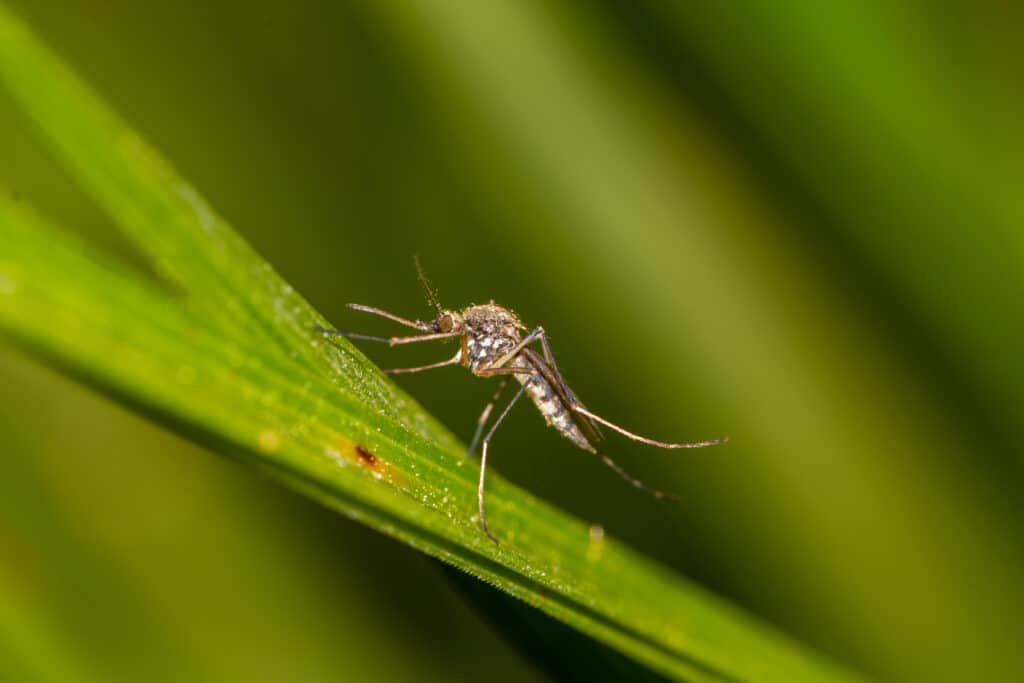
Large mammals such as
horses
, cows, and humans are their preferred targets.
©Roziline/Shutterstock.com
8. Eastern Saltmarsh Mosquito (Aedes sollicitans)
The eastern salt marsh mosquito produces a larva that can tolerate saltwater. They tend to breed in the saline wetlands on Georgia’s coastal shores and cause a real nuisance in marsh or swamp land. That said, this mozzie will travel 100 miles to conquer new habitats.
They are easy to recognize due to the pale stripe of scales that run along their abdomen centers and band their upper abdomens. Day and night feeders they bite aggressively and transmit eastern equine encephalitis and heartworm in dogs.
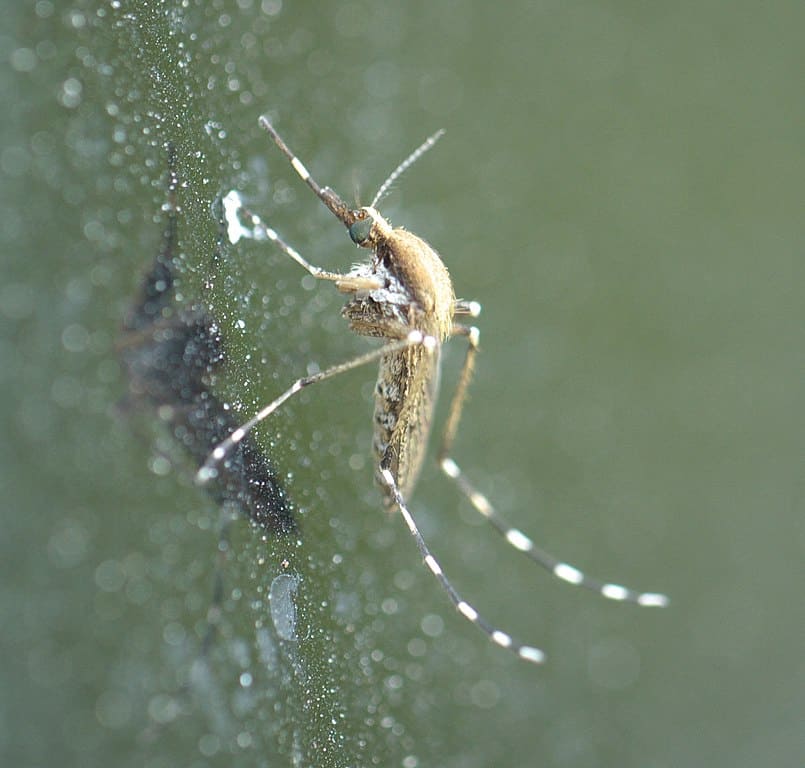
They tend to breed in the saline wetlands on Georgia’s coastal shores and cause a real nuisance in marsh or swamp land.
©xpda / CC BY-SA 4.0 – License
When Is Mosquito Season in Georgia?
The mosquitoes’ peak season is set to invade Georgia from June to July, but Georgia also hosts the winter marsh mosquito that bites year-round.
In general, the mozzies listed above start to emerge in March when Georgia’s temperatures approach 50 degrees Fahrenheit. They breed quickly in warm, humid weather and slow down when temperatures are low.
Unfortunately for Georgians, this means peak mosquito season is variable depending on the weather. You can be certain as soon as it warms up and there’s standing water nearby, all species of Georgian mosquito will look for a blood meal.
Except for winter marsh mosquitoes, the season ends when temperatures fall below 50 degrees Fahrenheit, which is usually November. Mosquitoes will either hibernate or die, depending on the species.
Where Do Mosquitos Live in Georgia?
Mosquitoes are dependent on water sources to breed. You’ll find them near sources of standing water or very slow-moving water. Some prime mozzie spots include:
- Old tires
- Buckets
- Flowerpots
- Birdbaths
- Ponds
- Wet mud
- Compost heaps
- Swimming pools
- Ditches
- Marshes
When females are not laying eggs in water, mosquito swarms hide in long, damp grass and shady spots near trees, shrubs, and vegetation.

You’ll find them near sources of standing water or very slow-moving water.
©Giovanni Seabra Baylao/Shutterstock.com
Other Insects Set to Emerge in Georgia
Georgia in springtime is beautiful. Many plants and animals are springing into life, and it’s a pleasure to watch, but it’s worth keeping an eye out for insects set to emerge in Georgia, too, because some of them can give a nasty bite or sting.
Fire Ants
With a cripplingly painful bite, fire ants in Georgia are most active from May until October or when temperatures hit 70-85 degrees. They invade homes and build sturdy ant hill structures in yards.
Fire ants are native to South America and attracted to electricity. Large nests need professional advice. Don’t attempt to tackle a large fire ant nest without good knowledge of their habits, or you could end up with numerous painful bites.

They invade homes and build sturdy ant hill structures in yards.
©Dalzon/Shutterstock.com
Cicada Killer Wasps
These mega-wasps emerge in Georgia around August time, and they’re active for about a month. They are large, measuring 1.5 inches long, and black or brown with yellow banding. They prey on cicadas and nest in the soil but give a painful sting to humans and animals if they are disturbed.
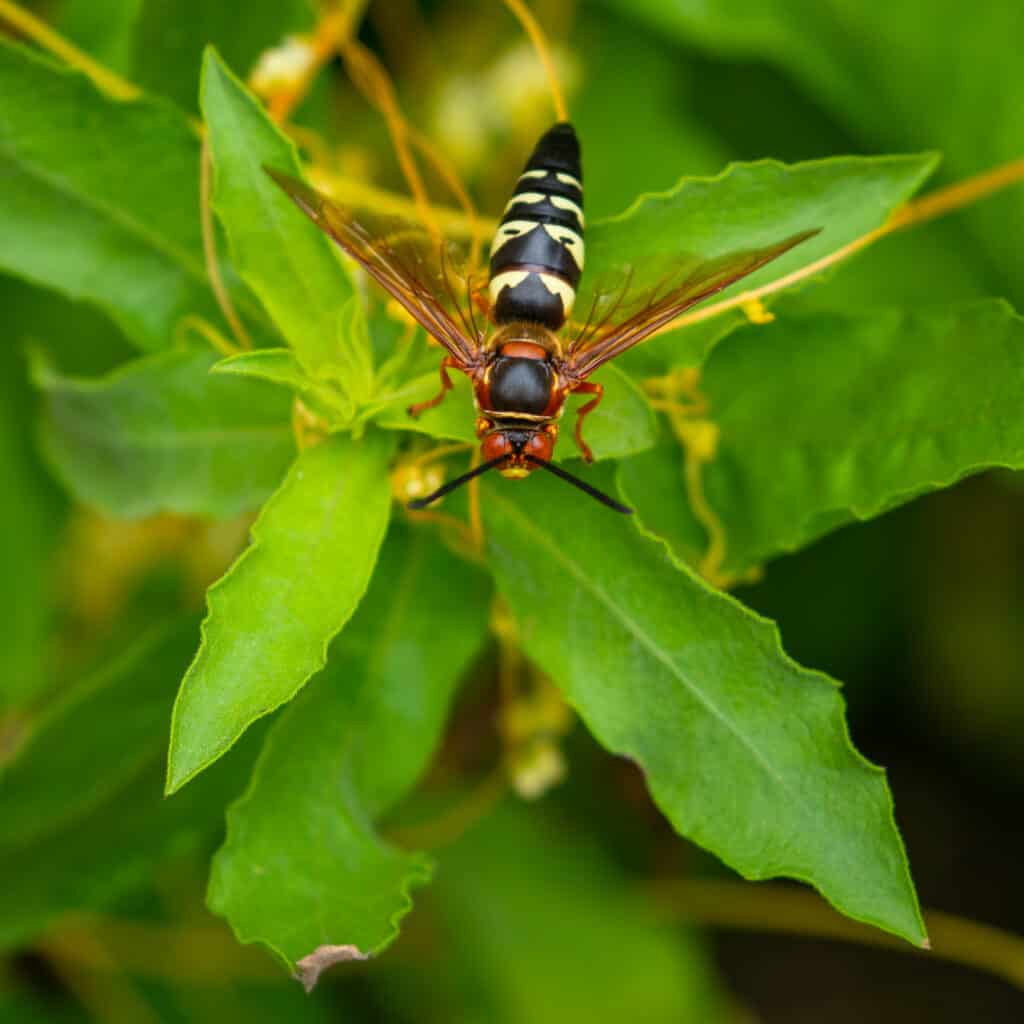
These mega-wasps emerge in Georgia around August time, and they’re active for about a month.
©iStock.com/Art Sublimina Photography
Saddleback Caterpillar
During June to July, spiky venom-filled saddleback caterpillars emerge from eggs and start to eat as much as possible. They don’t sting humans on purpose, but their inch-long bodies boast fleshy knobs on all sides, which deliver a very painful sting. You can recognize a saddleback caterpillar by its distinctive brown saddle mark.
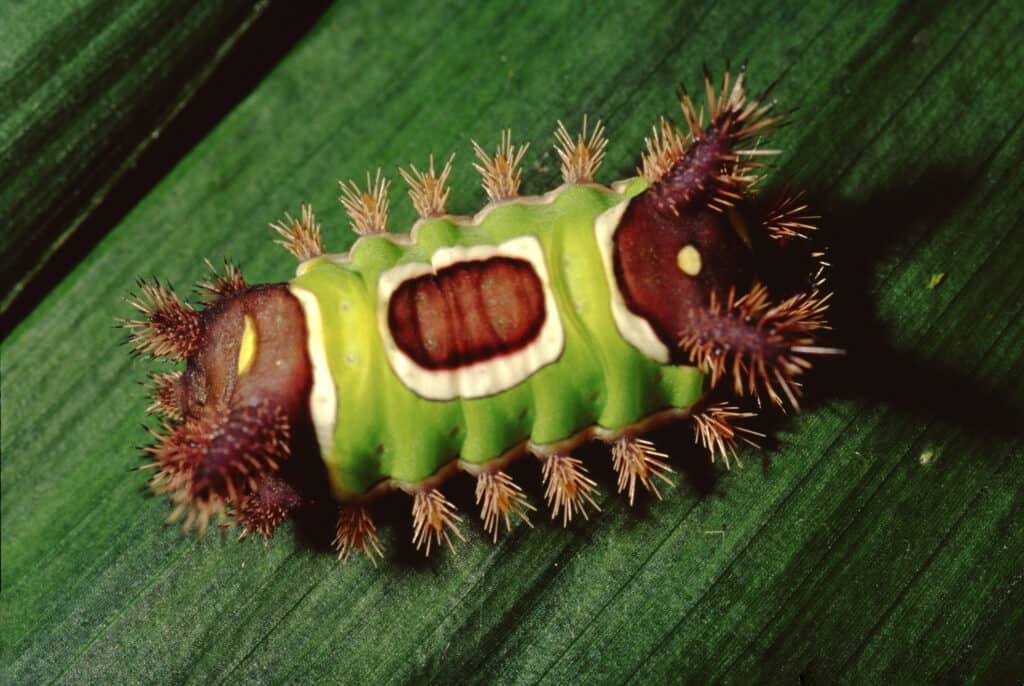
They don’t sting humans on purpose, but their inch-long bodies boast fleshy knobs on all sides, which deliver a very painful sting.
©Liz Weber/Shutterstock.com
Horse Flies
Horse flies are a real nuisance to horses, deer, and humans. Females require blood to create viable eggs, but unlike stealthy mosquitoes, their mouths are sharp. When they slice through skin to lap up our blood, it hurts.
Horse flies are active during the day and prefer dawn and dusk for their vampiric habits. They can reach 1.25 inches in length and show up in the warm months. For Georgians, that’s April onwards.
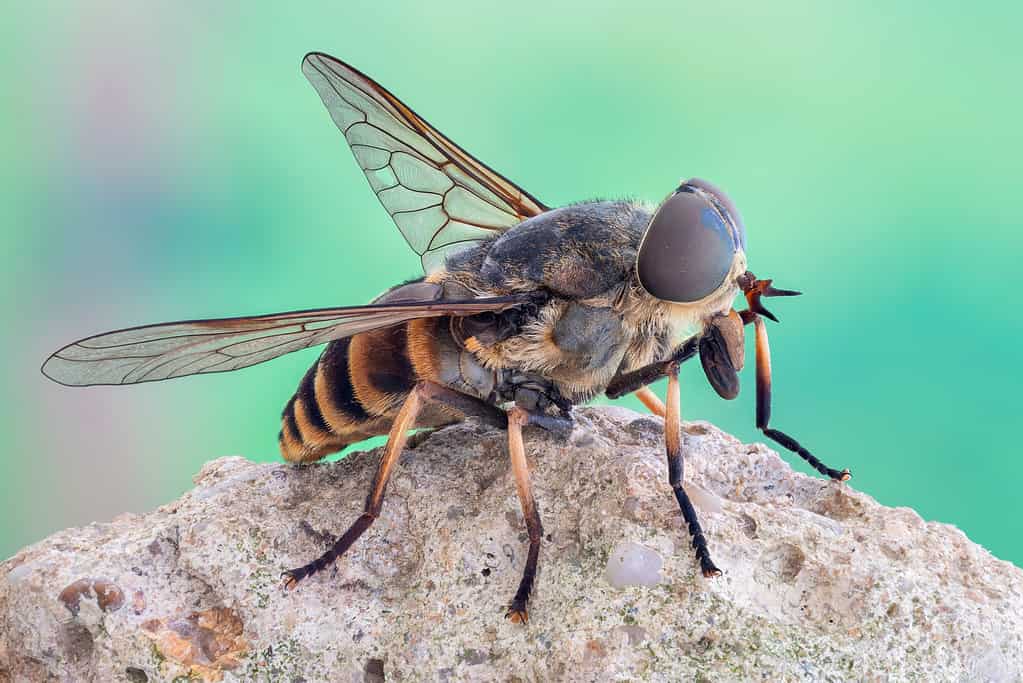
Females require blood to create viable eggs, but unlike stealthy mosquitoes, their mouths are sharp.
©iStock.com/guraydere
Types of Mosquitoes Set to Invade Georgia
Georgia is a mosquito hotspot from March onwards. Over 60 types of mosquitoes are set to invade Georgia every spring, so it’s best to get prepared. Eliminate all standing water, cut back long, damp grass, keep your skin covered, especially at dawn and dusk, and apply mosquito repellent.
The photo featured at the top of this post is © In The Light Photography/Shutterstock.com
Thank you for reading! Have some feedback for us? Contact the AZ Animals editorial team.



